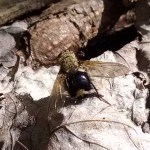A lot of insects are called flies like dragonflies or butterflies, but true flies are insects with only one pair of wings. We are most familiar with the obnoxious members of the group – the bloodsuckers such as mosquitoes and deer flies and their ilk, but the preponderance of fly species are beneficial or neutral in their relationship to humanity.
All flies consume food in liquid form. Bad types of flies are interested in people’s blood or sweat, or their lunch. But many good types of flies feed on flower nectar and in fact are important pollinators.
This week’s post is on one group of the gardener’s best friends – the tachinid flies, with almost 2000 species in North America alone. Tachinid flies are parasitoids, they usually lay their eggs on or near caterpillars but they have been known to parasitize scorpions and spiders as well as grasshoppers, beetles and other flies. The eggs hatch and the tachinid fly babies eat the caterpillar from inside. Many of the caterpillars that are pests in the vegetable garden are parasitized by tachinid flies. For instance, the cabbage looper is parasitized by two different species of tachinid fly.
Tachinid flies can be very effective in controlling caterpillar populations, with success rates of 70% control of pest populations frequently reported. Tachinid flies are commercially available as biocontrol agents because they are so effective.
And they are friends of the forest as well. A species of Tachinid fly is an important predator of the gypsy moth caterpillar, a well-known pest that can strip the leaves of all the trees on a hillside in a matter of weeks.
All the photos in this post were taken of insects collected in one week this April here in the Catskills.
Contact From Root To Shoot Now! Make your garden look its best for the whole season!!!








I love hearing another perspective of the reciprocity of symbiosis in nature this time through the lens of the Tachinids. Thank you Melissa!
Querida Melissa:
Resulta refrescante leer y aprender que los “bloodsuckers mosquitoes” tienen familias tan productivas e importantes
para el balance ecológico. !!!
Abrazo.
Titi Belencita